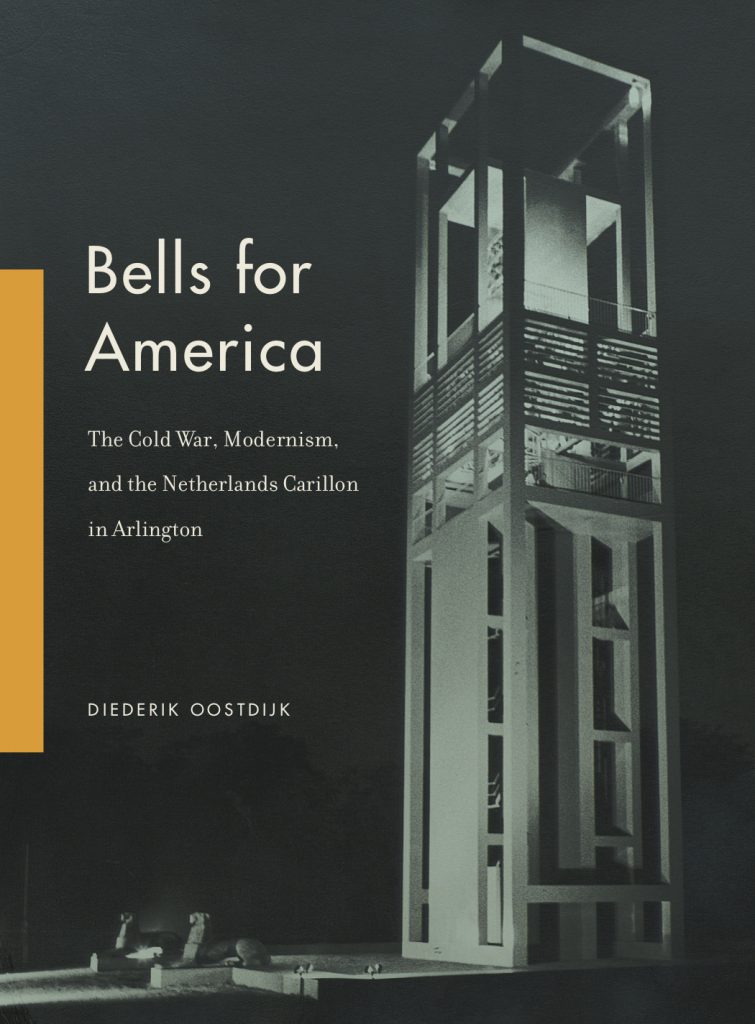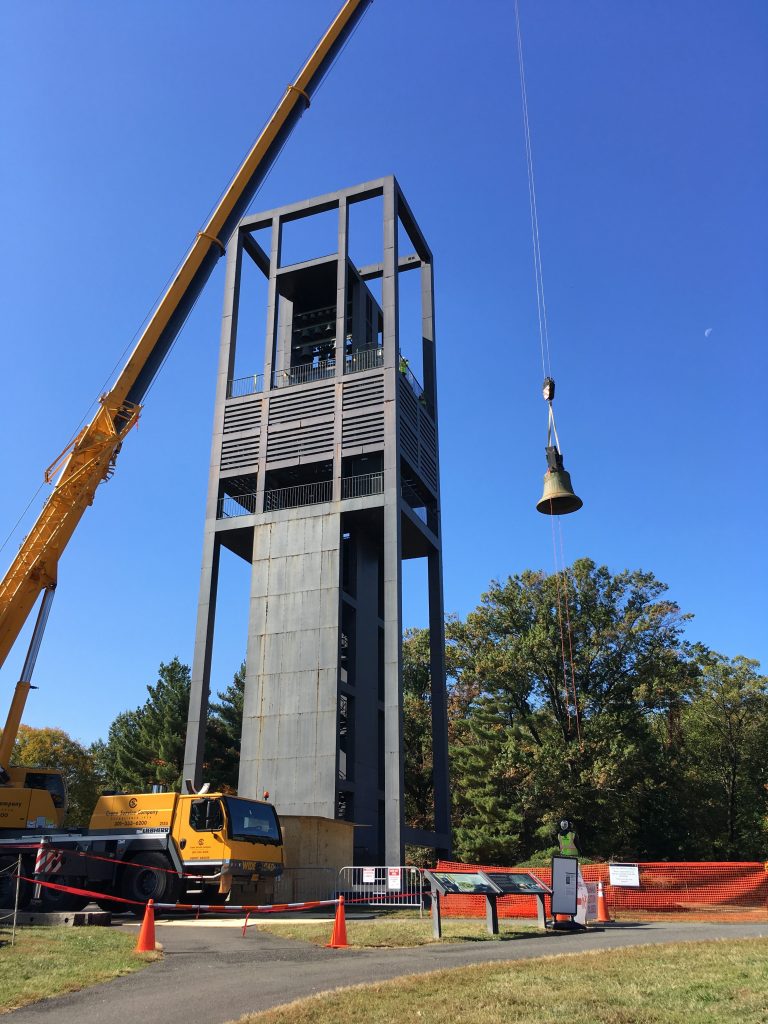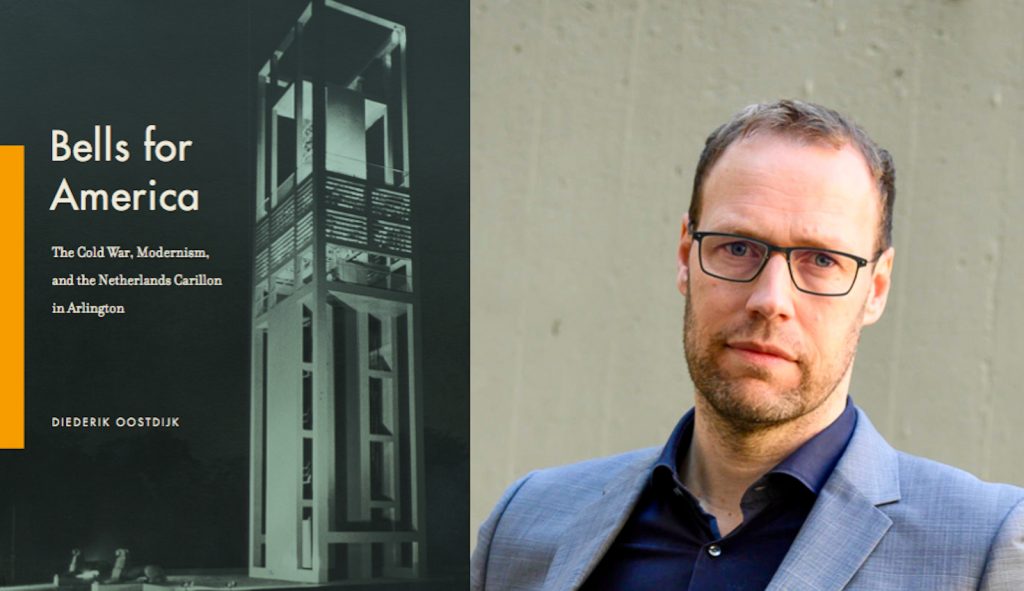Three years ago, I was an intern at the Interdisciplinary Conference on Netherlandic Studies, held on the University of Michigan-Ann Arbor campus. There, I met Diederik Oostdijk, an Amsterdammer who not only spent hours talking with me about 20th-century American poets, but who also encouraged my uncanny passion for the Dutch language. Preceding a special concert at the Burton Memorial Tower performed by U-M carillon professor, Tiffany Ng, Diederik gave a lecture called “Unity is Built on Harmony: The Netherlands Carillon as Political Instrument during the Cold War,” which would eventually grow into his new book, Bells for America: The Cold War, Modernism, and the Netherlands Carillon in Arlington (Penn State University Press, October 2019). I remember being shocked as I listened to Diederik’s presentation. I had visited the Washington, D.C. memorial landscape many times, including Arlington National Cemetery—how had I never even heard of the Netherlands Carillon?
In Bells for America, Diederik introduces an American audience to the discordant history of the Netherlands Carillon, a 127-foot steel bell tower containing fifty bells, just next to Arlington National Cemetery, on its northernmost tip. The carillon was originally given by the Dutch to the American people to thank them for liberating the Netherlands during World War II, and for the Marshall Aid the country received. However, Diederik’s illuminating and meticulously researched book uncovers how the carillon is merely a symbol of the impossibly complicated relationship between the United States and the Netherlands as both countries strived to reinvent themselves in the Cold War era.
Diederik Oostdijk is also the author of Among the Nightmare Fighters: American Poets of World War II (The University of South Carolina Press, 2011) and coeditor of Tales of the Great American Victory: World War II Politics and Poetics (VU University Press, 2006). He is currently a professor of English Literature at Vrije Universiteit Amsterdam.
Diederik spoke with Michigan Quarterly Review about the origin of his Netherlands Carillon project, the meaning of this Dutch gift to the US in today’s political climate, and the future of the Carillon which, until recently, had fallen into an embarrassing state of disrepair.
Cameron Finch (CF): How did you first become interested in the Netherlands Carillon? What drew you to research and write about its complex history?
Diederik Oostdijk (DO): By sheer accident! I literally stumbled upon the Netherlands Carillon when friends took me to Arlington decades ago. I was immediately baffled by the oddity of this dark, Dutch modernist bell tower surrounded by all those iconic American and mostly neoclassical monuments. It seemed so out of place, as if a foreign object had landed in a typically American memorial landscape. Yet Joost Boks’ angular and simple structure also struck a chord in me. I was also arrested by the architectural style because I recognized it from my childhood. The neighborhood I grew up in, in Nijmegen, was designed in a similar, postwar reconstruction style. Years later I found the archive of the Dutch Ministry of Affairs, especially the correspondence between them and Washington D.C., and the whole history unfolded itself in all its complexity. What particularly appealed to me was that although it is a story about a single monument, you need to look at the history of two nations, at musical history, at landscape architecture, art history, and campanology to make sense of it. The Netherlands Carillon can only be understood against a background of two nations trying to reinvent themselves during the Cold War.
CF: You mention in the introduction that bells are both a symbol of Dutch and American identity. While carillons have served as a distinct and prestigious source of pride in the Dutch city soundscape for centuries, famous bells in America such as the Liberty Bell have come to signify freedom and independence. What do bells personally symbolize for you?
DO: Bells evoke in me a profound sense of melancholy and, paradoxically, also joy. Tolling bells always shock me into a sense of reality when I am deeply immersed into my own thoughts. As such, they connect me with my own surrounding, but also with the passing of time, and my own sense of aging and eventual death. That sounds more dramatic than I intend it, as there is also a sense of acceptance of that inevitability. I have the feeling that others experience this also, but that for them it is something ineffable. I am much more attuned to bells now than before. I heard them everywhere, and I even see bells in cup-sized shapes that aren’t bells. I realize that this is not normal! When I hear carillon bells play, I notice they make me smile, and I try to make out what the carillonneur is playing up there somewhere high in the tower. They wield a particular sonic power over a town, a city, or community.

CF: In Bells for America, you argue that the Netherlands Carillon was not only given in gratitude for the U.S.’s role in liberating The Netherlands. The carillon is ultimately a Cold War Relic; a symbol of The Netherlands’ attempt to reinvent themselves as a resilient and modernizing culture during the Cold War period. Do you see echoes of The Netherlands’ “reinventing” in today’s world, too? How does the carillon’s Cold War history live on in the present?
DO: What a great question! I do. It is important to understand that in the 1950s, the Netherlands was really struggling with its national identity. Before World War II, its economy was largely based on possessing the Dutch East Indies, and politically it tried to be neutral. After having to give up Indonesia, after a horrific war in which my father was also drawn as a soldier, the Netherlands had to reinvent itself. The carillon became a symbol of that reconstruction. The Netherlands began to see itself as a small bell in the new world order, as Queen Juliana mentioned when she came over to Washington to hand over the first bell of the Netherlands Carillon to President Truman: in order to make a sound in the world, it had to cooperate and chime in with larger bells. All those supranational organizations, like the European Union, NATO, and the United Nations, were carillon-like organizations in which smaller and larger bells had to harmonize. It is remarkable that right now those organizations are hotly debated, with Brexit and with President Trump questioning the efficacy of the U.N. and NATO, for instance, and instead emphasizing the autonomy of individual nations.
The Netherlands is again renegotiating its national identity. Like in the 1950s, you have conservative and progressive forces pushing on both sides. On the one hand, you have Dutch people trying to hold on to old cultural traditions, such as Sinterklaas and Zwarte Piet, and the Golden Age of the 17th-century as a shiny example of an enterprising nation. Yet on the other hand, you have an increasing number of people who find those cultural manifestations offensive, as they are connected to a nefarious slave history. The Netherlands will give three extra bells to the United States in 2020, upgrading it to a Grand Carillon. Last week I spoke at a Dutch school in Bethesda, Maryland, and I asked the children what they felt ought to be represented on those three new bells. In addition to typical Dutch food items, some of them said that they ought to depict sustainable windmills, solar panels, and bikes on it, as ways in which we could “Save the Planet.” I thought those were remarkable answers, and they reflect how the Dutch could reinvent themselves. I told the kids I would mention this to the Dutch ambassador, André Haspels, who will decide what will be represented on those new bells. And I did when I saw him at the start of the rehabilitation of the Netherlands Carillon that is now underway.
CF: This book is chock full of historical quotes from Dutch and American texts, not to mention the biographies and stories of the hundreds of players who had a role in the “Bells for America” project. What was your process to get through all of that information? How did you consolidate your research? And what was a fascinating detail about the Carillon that you wanted to include, but couldn’t because of space or irrelevancy?

DO: I was amazed to discover how many people had been involved in the making of the Netherlands Carillon. Besides getting immersed in official archives, I was also able to retrieve lots of materials from family members of those who contributed to the Netherlands Carillon who kept memoirs, drawings, receipts, and even plaster casts of the images that adorn the bells. One amateur historian had saved the archive of one of the bell foundries from destruction, and was generous enough to share it with me. The grandson of the engraver who worked on the bells, Ernest Goyarts, is himself an engraver. When interviewing him, he wandered outside to his garden, and came back with a huge thirty-pound brass plate, and asked if it was connected to the Netherlands Carillon. Yes, it was the image that is attached to the largest bell of the Dutch Antilles, I answered sheepishly. He had no idea what it was, and for years it had been in the garden as decoration. It is a pity that I couldn’t dwell on those stories of all those individuals. Funnily enough, the book is about both dignitaries and heads of state, like ambassadors and queens and presidents, but it is also about the bell founders and engravers and artists who actually did the manual labor. It is a pity that I couldn’t name them all, or share all those amusing anecdotes. I was fascinated, for instance, by Paul Koning, the sculptor who designed the two peculiar lions that guard the bell tower. He was a pacifist and a bit of a hippie before those words existed, and initially scoffed at the idea of furnishing a bell tower for what he considered was an imperialist, capitalist country. The architect, Joost Boks, was really irritated by Koning’s dismissal of the Netherlands Carillon as only a gift to please the American government. In a sense, their argument was also a generational conflict between one generation seeing the United States as the benevolent liberator and the next seeing it as an imperialist world force.
CF: Has your view toward the Carillon changed since your first visit in 1997? How has writing this book complicated or transformed your connection with the memorial? And what do you hope your readers keep in mind when they next pay a visit to the Carillon in Arlington?
DO: I don’t think it has fundamentally changed. I was confounded when I first saw it there next to Arlington National Cemetery and overlooking those famous monuments in Washington D.C. Writing the book was a journey to discover how it ended up there. I hope that readers of the book and visitors to Arlington will understand that this monument is more than just a story of Dutch gratitude to its powerful ally, but also a story of dissonance. There was constant bickering: between the Dutch bell foundries, the artists working on the bells, the politicians who were involved, but also between the Dutch and Americans. A veterans’ organization did not want the Netherlands Carillon to be placed so close to Arlington National Cemetery, and the Commission of Fine Arts also preferred that the bells would have wound up in a park in Washington D.C. They also felt that the bell tower was a bit too new, a bit too modern. The musical instrument also literally sounded dissonant, as the three bell foundries who cast the bells were forced to work together. Each of the three had slightly different methods for casting pure-sounding bells, and as a consequence, the bells sound off. During the renovation that is now underway, all the bells will be brought back to the Netherlands and retuned by Royal Eijsbouts. After that has happened, they will sound harmonious together for the first time in history. This story of dissonance as well as harmony is much more truthful to how two nations coexist in this complex world, and once you realize that, you can look with more appreciation at this Dutch gift.
CF: What is the future for the Netherlands Carillon?

Arlington National Cemetery,
Washington, D.C.
DO: I sincerely hope that Bells for America and the rehabilitation project that will be completed in 2020 will ensure that the Netherlands Carillon will no longer be a dissonant note in the American memorial landscape. The Singing Bronze Foundation will develop a plan to ensure that more Arlingtonians and visitors will resonate more with this carillon. There are plans to increase the number of concerts, and to train more guides to tell the fascinating but complex history of this unique monument. A carillon is essentially an enormous jukebox, and it should be possible to attract more attention to this instrument. Yet there is always a danger that after the renovation, the monument will once again fall into disrepair. Carillons need constant care and attention. They are “living memorials,” as Frank P. Law, the first carillonneur-director of the Netherlands Carillon once stated. I am sure, though, that if the Singing Bronze Foundation, the National Park Service, the Dutch Embassy, and the Guardians of the Netherlands Carillon work harmoniously together, the Netherlands Carillon will play for generations to come.
CF: This book also speaks to widespread cultural amnesia—a collective “forgetting.” There are millions of American and Dutch people who have no clue that the Netherlands Carillon even exists, not to mention the tumultuous story of its becoming. Do you have any plans for this book to be written or translated into Dutch for a Netherlandish audience?
DO: Yes, a shorter Dutch version will be published in the spring of 2020 to accompany a museum exhibit that will be held at Museum Klok & Peel in Asten, the Netherlands. The book will contain even more images, and is targeted more at a Dutch audience, highlighting how the Netherlands Carillon is a self-representation in bronze. The 1950s is often presented as a time when things were simpler and less problematic. Yet Bells for America and its Dutch spinoff belies that. You are absolutely right that this history was turbulent, and that cultural memory often presents that postwar era with a false sense of comfort that was not experienced by the people who lived through it.
CF: I noticed that Tiffany Ng, a U-M assistant professor of carillon, is quoted in your book. I’m wondering if she shared with you any history about the University of Michigan’s campus carillons and bell towers?
DO: She did, and I was lucky enough to hear her play the Baird Carillon from high up in the tower when I visited Ann Arbor a few years ago. Tiffany has written insightfully about the Netherlands Carillon in her dissertation, and I admire her imaginative scholarship on campanology. Joost Eijsbouts, the president of the bell foundry who will retune the bells of the Netherlands Carillon, also told me about the casting of the Lurie carillon on U-M’s North Campus. It was one of his first assignments as CEO of Royal Eijsbouts. The state of Michigan is blessed with many fine carillons across the state. Detroit has three, I believe, and Bloomfield Hills has two, including the one of Kirk in the Hills, which has 77 bells, the second largest number in the world. Moreover, Michiganders of Dutch descent have also contributed to the rehabilitation project that has just started. The Netherlands Carillon will ring out in harmony in 2020, partly due to those anonymous donations.
Author photo courtesy of Richard Mouw. Photo of the Netherlands Carillon courtesy of Diederik Oostdijk.




